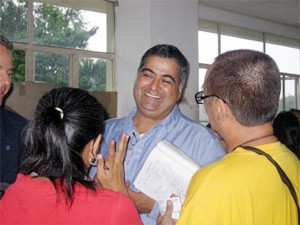Dilemmas

Misal Khan’s town in Pakistan became the target of a bombardment and his family hid in the basement to shelter from the attack. Now, they live in Jalozai camp, home to more than 200,000 internally displaced people. Video by UNHCR
[Note: 20 June 2012 is World Refugee Day. Displaced communities, governments and humanitarian agencies observe this day to raise awareness on the plight of the world’s 42.5 million displaced. A wide range of activities will take place across the globe throughout the week to mark this day.]
After repeated threats to his life and unremitting surveillance from a cabal of security forces in 2008, Paul was faced with a dilemma: stay and risk further persecution, maybe even death, or escape, but leave his loved ones behind.
The government was on a crackdown against a separatist militant organization responsible for attacks on villages and prominent leaders. His country was embroiled in a bloody civil war. Paul decided that it was finally time to leave.
In search of a solution to his situation, Paul arrived in the Philippines and was recognized as a refugee. At the end of 2011, 42.5 million people around the world with similar stories to Paul were forcibly displaced. This figure includes 15.2 million refugees, 895,000 asylum-seekers, and 26.4 million internally displaced people.
Refugees are people with histories, stories and aspirations. A refugee can be anyone around you because just as no one chooses to be a refugee, anyone could potentially become a refugee. Refugees are not only the almost 500,000 people living in Dadaab, the biggest refugee camp in the world, or others in the same situation. Rather, millions are building or re-building new lives in many cities and towns across the world, positively contributing to their host society in a number of ways.

The Philippines has provided a new home to scores of refugees over the years. One success story is that of Buick Bahador, the first refugee to be sworn in as a citizen of the Philippines in 2006. Photo by UNHCR
Paul is doing just that here in the Philippines. He works as a supervisor in a factory and has trained scores of Filipinos on the basics of glass manufacturing. Before having been forced to flee, Paul was a programming lecturer at a university in his country of origin and was a computer software engineer.
The Philippines is, in fact, a country that is not alien to the refugee experience. It was built and re-built on the sweat and tears of many individuals who were forced into exile due to persecution on account of their political beliefs and found protection and relief from persecution. We recall episodes of exile endured by some of this country’s national heroes such as Emilio Aguinaldo and Ninoy Aquino.
At the dawn of World War II, 11 years before the international community adopted the Refugee Convention, the government passed the Philippine Immigration Act of 1940. Section 47(b) of the law reads that the President for “humanitarian reasons, and when not opposed to the public interest” may admit “aliens who are refugees for religious, political, or racial reasons…”
This text in Philippine law is remarkable for a number of reasons. First, it was adopted by the Philippines at a time when Europe, which often boasts about being the “cradle of human rights”, was engulfed in
one ogenerating millions of victims including refugees.
Second, the text is visionary as it was promulgated 11 years before the world agreed on the definitions of concepts including “humanitarian” and “persecution”. Credit goes to visionary Filipino lawmakers who drafted such a progressive and liberal text in 1940. How I wish decision-makers of this generous nation would one day consider including it as part of the school curriculum—to teach the children of this country that their ancestors in 1940 had already anticipated the necessity of being tolerant and hospitable and offering protection to people fleeing persecution.
Filipinos may not be fully aware, but their nation was among the first to spontaneously offer asylum to successive waves of refugees fleeing persecution. Who remembers Vice-Admiral Oskar Victorovich Stark who led “white Russians” in the 1920s in escaping the turmoil in their country? Who remembers the Jewish victims of rising totalitarian ideology in Europe landing on the shores of the Philippines in the late
1930s? Who remembers the arrival of pro-republican Spaniards seeking asylum in the Philippines after the end of the civil war in Spain? What about the 500,000 Indochinese refugees who either sought asylum or transited through the Philippines in search of a new home?
Over the years, the shores of the Philippines have provided a safe haven for hundreds of thousands of refugees like Paul.
Bernard Kerblat, Representative of the United Nations High Commissioner for Refugees (UNHCR).